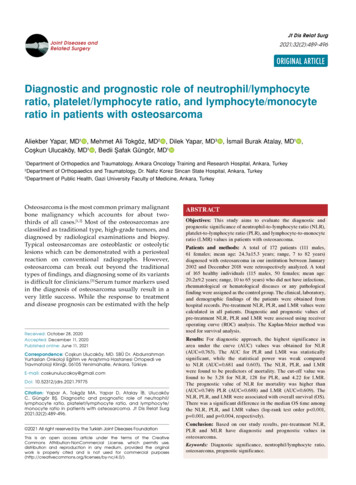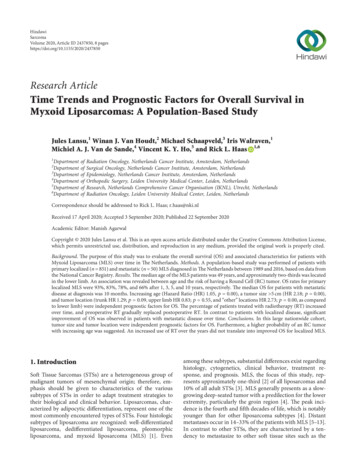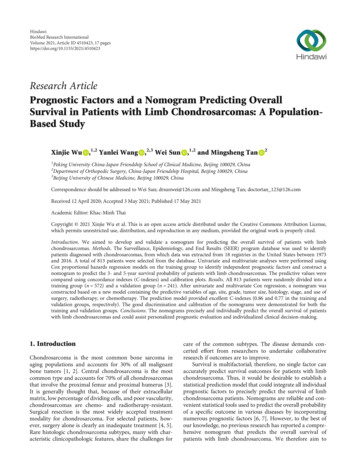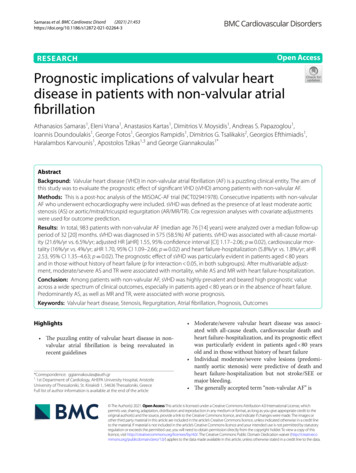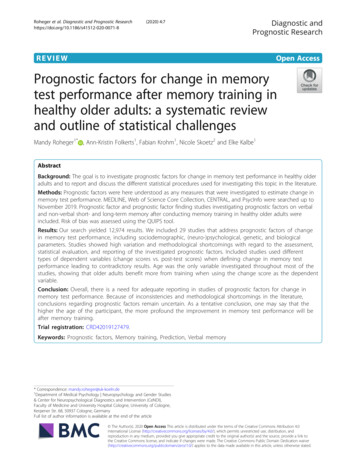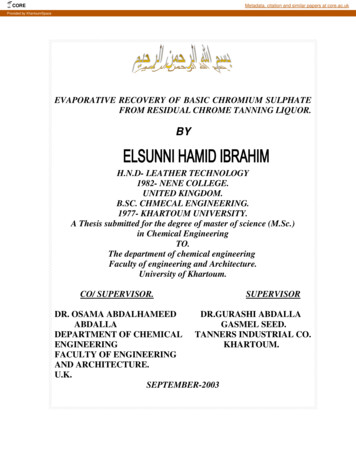
Transcription
Wang et al. BMC Cancer(2021) SEARCH ARTICLEOpen AccessPrognostic value of visual residual tumourcells (VRTC) for patients with esophagealsquamous cell carcinomas afterneoadjuvant therapy followed by surgeryXingxing Wang1†, Hao Wang2†, Haixing Wang1, Jie Huang1, Xin Wang1, Zhengzeng Jiang1, Lijie Tan2,Dongxian Jiang1* and Yingyong Hou1,3,4*AbstractBackground: We assessed visual residual tumour cells (VRTC) with both Becker’s tumour regression grading (TRG)system and Japanese TRG system in esophageal squamous cell carcinoma (ESCC) patients treated with neoadjuvanttherapy followed by surgery.Methods: We compared Becker system and Japanese system in 175 ESCC patients treated between 2009 and 2015.Results: According to Becker system, the 5-year DFS/DSS rates were 70.0%/89.3, 53.8%/56.7, 43.0%/49.0, and 42.4%/39.1% for TRG 1a (VRTC 0), TRG 1b (1–10%), TRG 2 (11–50%), and TRG 3 ( 50%). According to Japanese system, therates were 38.8%/34.1, 49.5%/58.7, 50.2%/49.0 and 70.0%/89.3% for Grade 0-1a (VRTC 66.6%), Grade 1b (33.3–66.6%), Grade 2 (1–33.3%) and Grade 3 (0). TRG according to two systems significantly discriminate the patients’prognosis. TRG according to Becker system (HR 2.662, 95% CI 1.151–6.157), and lymph node metastasis (HR 2.567,95% CI 1.442–4.570) were independent parameters of DSS.Conclusions: Both Becker and Japanese system had their advantage in risk stratification of these ESCC patients. Itwas speculated that dividing 1–10% VRTC into a group might contribute to independently prognostic significanceof Becker’s TRG system. Therefore, in addition to TRG of different systems, the percentage of VRTC might berecommended in the pathologic report, which could make the results more comparable among differentresearches, and more understandable for oncologists in the clinical practice.Keywords: Neoadjuvant therapy, Esophageal squamous cell carcinoma (ESCC), Visual residual tumour cells (VRTC),Tumour regression grading (TRG), Lymph node metastases (LNM)* Correspondence: jiangdongxian3@aliyun.com; houyingyong@aliyun.com†Xingxing Wang and Hao Wang contributed equally to this work.1Department of Pathology, Zhongshan Hospital, Fudan University, Shanghai200032, People’s Republic of ChinaFull list of author information is available at the end of the article The Author(s). 2021 Open Access This article is licensed under a Creative Commons Attribution 4.0 International License,which permits use, sharing, adaptation, distribution and reproduction in any medium or format, as long as you giveappropriate credit to the original author(s) and the source, provide a link to the Creative Commons licence, and indicate ifchanges were made. The images or other third party material in this article are included in the article's Creative Commonslicence, unless indicated otherwise in a credit line to the material. If material is not included in the article's Creative Commonslicence and your intended use is not permitted by statutory regulation or exceeds the permitted use, you will need to obtainpermission directly from the copyright holder. To view a copy of this licence, visit http://creativecommons.org/licenses/by/4.0/.The Creative Commons Public Domain Dedication waiver ) applies to thedata made available in this article, unless otherwise stated in a credit line to the data.
Wang et al. BMC Cancer(2021) 21:111BackgroundEsophageal cancer (EC) is the ninth most common cancer and the sixth most common cause of cancer deathglobally [1]. Chinese population-based studies haveshown approximately 477,900 persons receive a diagnosis of EC, and 375,000 persons died of EC in 2015, ranking it as the third most commonly diagnosed cancer andthe fourth leading causes of cancer death in China [2].Surgical resection has been the mainstay of treatmentfor EC. However, the majority of patients with locallyadvanced EC who undergo surgical resection eventuallydevelop local recurrence or distant metastasis, and the5-year survival rate is only 5–34% [3]. In an attempt toimprove survival, many investigators around the worldhave assessed multidisciplinary strategies. The preoperative neoadjuvant chemotherapy (nCT) or chemoradiotherapy (nCRT) combined with surgery have gainedmore attention in the treatment of locally advanced EC[4, 5]. Several studies have shown that neoadjuvant therapy (nCT or nCRT) followed by surgery significantly improves disease free survival (DFS) and overall survival(OS) compared with surgery alone, making it standardtherapy for locally advanced EC [6–9]. Accumulatingevidence indicates that the histological evaluation of theregression response to nCT or nCRT is the most important predictor of survival [5, 10].Tumour regression grade (TRG) system referring tothe amount of therapy-induced fibrosis in relation to residual tumour after nCRT has been initially developedby Mandard and coworkers [11]. However, the reproducibility and prognostic value of this system has beenchallenged because of the difficulties in the assessmentof the relative amount of fibrosis [12]. Then the quantitative analysis of regression response through the estimated percentage of visual residual tumour cell (VRTC)in relation to the previous tumour site has been proposed. At present, there are several classification systems(2 to 5 grades) available in the literature, with the cut-offvalue of 1, 10 and 50% [13–18]. Among the systems, amodification of 4-tiered Becker system not only resultedin statistically superior rates for interobserver agreementbut also in achievement of a better prognostic impact inmany reports [19]. Besides, TRG system with cutoffvalue of 1/3 and 2/3, according to Japanese Classificationof Esophageal Cancer, has also been widely used inesophageal squamous cell carcinoma (ESCC) [20, 21].The larger retrospective studies found that the Japanesesystem was also simple, reproducible and prognosisassociated [22, 23]. At present, there was no study tocompare the application of the 2 major approaches(Becker system and Japanese system) for assessment ofVRTC in ESCC after neoadjuvant therapy.In the ESCC patients with neoadjuvant therapy, wecompared the Becker system and Japanese system forPage 2 of 10assessment of VRTC, and tried to explore the prognosticfactors.MethodsPatientsThis study was based on a retrospective review of 175patients who underwent surgical resection following 2 to3 cycles of neoadjuvant chemotherapy (nCT) or neoadjuvant chemoradiotherapy (nCRT) for ESCC, betweenNovember 2009 and December 2015 at ZhongshanHospital, Fudan University, Shanghai, China. They werediagnosed as locally advanced-stage disease (clinical T3–4), using endoscopy, computed tomography (CT) of thechest and abdomen, endoscopic ultrasound, and positron emission tomography (PET), and required neoadjuvant treatment as first-line treatment prior to surgicalresection. Informed consents were obtained from all patients. This study was approved by the Institutional Review Board of our hospital (B2016–135) and wasperformed according to the ethical principles of the Declaration of Helsinki.The patients were followed up routinely in outpatients,every 3 months in the first year and every 6 months inthe second year, followed by annual evaluations. Patientswho did not go to our hospital were contacted by telephone to obtain follow-up data.Pathological analysisFor specimens with neoadjuvant therapy in our hospital,all the suspected area of tumors were embedded andsectioned after the macroscopic examination, and allslides were evaluated by pathologists at once. For thisstudy, all 175 surgically resected ESCC specimens weresystematically reevaluated histopathologically by two experienced gastrointestinal pathologists. The histopathological review was undertaken with the pathologistsblinded to the treatment results. The original tumourarea was identified by signs of tumour regressionchanges, such as marked fibrosis, necrosis, flattening ofthe mucosa, or the presence of foreign body giant cellreaction. The extent of VRTC was assessed semiquantitatively, based on the estimated percentage of cancer inrelation to the total cancer area [19–21]. With the repeated observation of tumour regression changes andtraining in evaluating standard, a consistency of 99% wasachieved by the two pathologists. So far, several TRGsystems have been used to assess the pathologic response to preoperative neoadjuvant therapy. In ourstudy, the extent of VRTC was divided into four categories according to Becker regression criteria [19] or theJapanese Classification of Esophageal Cancer [20, 21].Other clinicopathologic characteristics were also recorded, including age, gender, tumour location, tumourgrade, tumour size (measured during the pathological
Wang et al. BMC Cancer(2021) 21:111sampling), lymphovascular invision, perineural growth,number of positive lymph nodes (LN), and the type ofneoadjuvant.Statistical analysisCategorical data were analyzed using χ2 test or Fisher’sexact test. Survival curves were estimated using theKaplan–Meier method and were compared using thelog-rank test. Overall survival (OS) was defined as theperiod from the date of surgery until the last confirmeddate of survival or the date of death. Disease specific survival (DSS) was defined as the period from the date ofsurgery until the date of death, because of ESCC. Diseasefree survival (DFS) was defined as the period from thedate of surgery until the date of disease progression orthe date of death, because of ESCC. The Cox proportional hazard model was used to examine the associationbetween clinicopathological factors and survival, to identify independent prognostic factors. Hazard rates (HRs)with its 95% confidence intervals (95% CIs) were used todetermine the effect of each variable on outcome. Statistical analysis was performed using the SPSS software,version 21.0 (SPSS Inc., Chicago, IL), with statistical significance being considered with P 0.05 (two-sided).ResultsPatient and general pathological characteristicsThe clinical and pathological characteristics of the 175patients are summarized in Table 1.There were 148 maleand 27 female patients with a mean age of 59.8 (range41–73) years. Tumours were most often located in midesophagus (n 82) compared with the upper third (n 29) or the lower third (n 64). The mean tumour lengthwas 2.9 (range 0.3–9.0) cm. One hundred eight patients(61.7%) were treated with preoperative chemotherapy,whereas 67 (38.3%) patients were treated with preoperative chemoradiotherapy. No residual tumour was foundin 26 patients. Vessel and nerve invasion were identifiedin 57 (32.6%) and 56 (32.0%) tumours, respectively. In83 patients who had positive LN status, 51 patients(61.5%) had 1–2 positive LN, 23 patients (27.7%) had 3–6 positive LNs, and 9 patients (10.8%) had more than 6positive LNs.Effect of neoadjuvant therapy on ESCCTRG system of Becker or Japanese Esophageal CancerAssociation was widely accepted in western country orJapan, which was used in our study, separately. According to the Becker system, there were 26 cases (14.9%) ofTRG 1a, 36 cases (20.6%) of TRG 1b, 33 cases (18.9%) ofTRG 2, and 80 cases (45.7%) of TRG 3 (Fig. 1). Namely,62 tumours (35.4%) showed a histopathological responseof TRG 1a or 1b, whereas the remainder showed minoror no response (Table 1). According to the JapanesePage 3 of 10system, there were 64 cases (36.6%) of Grade 0-1a, 28cases (16.0%) of Grade 1b, 57 cases (32.6%) of Grade 2,and 26 cases (14.9%) of Grade 3. Namely, 83 tumours(47.4%) showed a histopathological response of Grade 2or 3, whereas the remainder showed minor or no response (Table 1).Table 1 depicts the associations between TRG and different pathological variables. According to Becker andJapanese system, we found that more VRTC (reflectingpoor response following neoadjuvant treatment) weresignificantly associated with longer tumour length,poorly differentiated tumour, lymphovascular invasion,perineural invasion, lymph node metastases (LNM) andsingle neoadjuvant treatment (Chemotherapy alone) (P 0.05) (Table 1).Survival analysisThe median follow-up duration was 24.0 months (range,2 to 86 months). At the time of analysis, 70 patients(40.0%) had disease progression and 59 patients (33.7%)had died of esophageal cancer. At total, 68 patients(38.9%) died. The 1-, 2-, 3-, and 5-year postoperativeDFS rates for the patients in this study were 82.8, 63.9,57.6, and 50.3%, respectively. The 1-, 2-, 3-, and 5-yearpostoperative DSS rates for the patients in this studywere 91.0, 73.4, 60.9, and 51.0%, respectively. The 1-, 2-,3-, and 5-year postoperative OS rates for the patients inthis study were 88.8, 72.4, 56.9, and 45.6%, respectively.Histopathological TRG as a prognostic factorHistopathological TRG was found to be strongly associated with survival. When the patients were categorizedaccording to Becker system (TRG 1a, TRG 1b, TRG 2,and TRG 3), the 5-year DFS rates were 70.0% (mediantime 72 months), 53.8% (non-reached), 43.0% (29months), and 42.4% (32 months), 5-year DSS rates were89.3% (median time non-reached), 56.7% (median timenon-reached), 49.0% (34 months), and 39.1% (36months), and the 5-year OS rates were 72.2% (mediantime 78 months), 50.0% (non-reached), 50.0% (34months), and 34.1% (34 months), respectively. Significantdifferences in DFS and DSS were observed between patients with TRG 1a/1b and TRG2/3 (P 0.05) but not between patients with TRG1a and TRG1b (P 0.05)(Fig. 2). When the patients were categorized accordingto Japanese system (Grade 0-1a, Grade 1b, Grade 2 andGrade 3), the 5-year DFS rates were 38.8% (median time32 months), 49.5% (36 months), 50.2% (non-reached)and 70.0% (72 months), the 5-year DSS rates were 34.1%(median time 36 months), 58.7% (non-reached), 49.0%(58 months) and 89.3% (non-reached), and the 5-yearOS rates were 31.1% (median time 31 months), 52.8%(non-reached), 45.4% (58 months) and 72.2% (78months), respectively. Significant differences in DSS
Wang et al. BMC Cancer(2021) 21:111Page 4 of 10Table 1 Clinical and Histopathological Characteristics in 175 Patients With ESCC Treated With Neoadjuvant therapy Plus SurgicalResectionnPercent (%)tumour regression grade (Becker)TRG 1a-1b%Agetumour regression grade (Japan)P valueGrade 2–3%3442.54951.60.168 608045.72430.0 Anatomic locationUpper third0.1180.221Middle third8246.92530.53745.1Lower third6436.62234.42843.8 3 cm9051.44145.65864.4 3 cm8548.62124.72529.4Size0.004Lymphovascular invasion 0.001 0.001 11017.9Perineural growth 0.001Lymph-node metastasis 0.001 0.001 2ypN22313.1417.4626.1ypN395.10000ypN-stage 0.001Type of neoadjuvant 0.001 0.001 apy6738.33958.25379.1tumour regression grade tumour regression grade (Japan)G0-1a6436.6G1b2816.0G25732.6G32614.9P value
Wang et al. BMC Cancer(2021) 21:111Page 5 of 10Fig. 1 Histologic examples of different extent of visual residual tumour cells (VRTC) in ESCC treated with neoadjuvant therapy and surgery (100 ):a no VRTC: evident fibrosis and chronic inflammatory infiltrate without detectable tumor cells (TRG 1a according to Becker system or Grade 3according to Japanese system); b little VRTC: fibrosis with rare small groups of tumor cells (TRG 1b according to Becker system or Grade 2according to Japanese system); c many VRTC: fibrosis and tumor cells with preponderance of tumor cells; and d no regression response: no signsof treatment effectwere observed between patients with Grade 3 and thosewith Grade 0-1a, 2 and 3 (P 0.05) (Fig. 3).Independent prognostic factorsThe univariate analysis showed a significant DFS difference in 5 factors: tumour grade, lymphovascular invasion, perineural growth, LNM, and TRG. The univariateanalysis showed a significant DSS difference in 6 factors:tumour size, lymphovascular invasion, perineuralgrowth, LNM, and TRG. The multivariate analysis identified that TRG (Becker system) (HR, 2.050; 95% CI,1.084 to 3.878 for DFS) (HR, 2.367; 95% CI, 1.123 to4.991 for DSS) was potentially independent factor ofDFS and DSS. Beside TRG, LNM (HR, 1.770; 95% CI,1.069 to 2.932 for DFS) (HR, 2.496; 95% CI, 1.416 to4.402 for DSS) was also independent factor of DFS andDSS (Table 2).DiscussionIn the present study, we retrospectively analyzed theclinicopathological data and outcomes of 175 patientswith ESCC who underwent nCT or nCRT followed bysurgery and elucidated the relationships between theclinicopathological characteristics. We designed thecurrent investigation specifically focusing on patientswith ESCC, which is the most common histological subtype of EC, particularly in China [2]. To the best of ourknowledge, less related study has been conducted inChina.Neoadjuvant therapyPrior to the emergence of chemotherapy and radiotherapy, surgical resection had been the curative treatmentof first choice in EC. At present, neoadjuvant therapy isused widely for patients with locally advanced EC. Evidence indicates that neoadjuvant therapy (nCT ornCRT) significantly improves survival in patients withlocally advanced EC compared with surgery alone [4, 6,7]. In our series, the 5-year survival rate was 45.6%. Inour center, the 5-year survival rate was 39.7% for patients undergoing surgery alone [24]. Other results [25]showed significant 13% increase in 5-year survival forneoadjuvant therapy plus surgery as compared with surgery alone.A reliable prognostic factor for ESCC patients undergoing neoadjuvant therapy is lacking. As preoperativeneoadjuvant therapy has been used increasingly in themanagement of locally ESCC patients, the identificationof potential prognostic parameters in these patients hasrecently gained momentum.Histopathological evaluation of tumour responseHistopathological tumour response after neoadjuvanttherapy is believed to be an important objective factor
Wang et al. BMC Cancer(2021) 21:111Page 6 of 10Fig. 2 Kaplan–Meier curves for DFS and DSS in patients with ESCC treated with neoadjuvant therapy and surgery stratified by tumour regressiongrade according to Becker systemand has been shown to have prognostic value in severalstudies [12–14, 26]. Response of the primary tumourcan range from the absence of response to a totalresponse with no VRTC. There is a consensus that thepatients with pathologic complete response after neoadjuvant therapy benefit from these treatment modalitieswith 5-year survival rates up to 60% [25, 27, 28]. Partialtumour response is a matter of ongoing debate withcontroversial results from different trials [23, 29].There are several classification systems available inthe literature, with classification of responders varyingfrom a 1 to 50% of VRTC [15, 30]. We present abrief review of the literature on classification systemsused to assess the pathologic response to preoperativeneoadjuvant therapy, and outline the most commonlyused TRG systems, to assess if tumour regressiondoes predict statistically significant improvement inOS and DFS.Fig. 3 Kaplan–Meier curves for DFS and DSS in patients with ESCC treated with neoadjuvant therapy and surgery stratified by tumour regressiongrade according to Japanese system
1.356 (0.799–2.301)1.770 (1.069–2.932)2.050 (1.084–3.878)Perineural growth (Negative VS. Positive)Lymph-node metastasis (Negative VS. Positive)Tumour regression grade- (Becker system) (TRG 1a 1b VS. TRG2 3)–1.096 (0.625–1.922)1.431 (0.832–2.460)1.826 (1.097–3.038)1.378 (0.787–2.414)Size ( 3 cm VS. 3 cm)Lymphovascular invasion (Negative VS. Positive)Perineural growth (Negative VS. Positive)Lymph-node metastasis (Negative VS. Positive)Tumour regression grade- (Japanese systerm) (G0-1a 1b VS. G2 3)Multivariate analysis 20.2590.980 943–Size ( 3 cm VS. 3 50.638P valueLymphovascular invasion (Negative VS. Positive)Multivariate analysis 11.863 (1.143–3.037)Lymph-node metastasis (Negative VS. Positive)Tumour regression grade- (Japanese systerm) (G0-1a 1b VS. G2 3)2.127 (1.316–3.438)Perineural growth (Negative VS. Positive)1.208 (0.745–1.959)1.879 (1.157–3.052)Lymphovascular invasion (Negative VS. Positive)2.596 (1.462–4.607)1.748 (1.082–2.824)Size ( 3 cm VS. 3 cm)Tumour regression grade- (Becker system) (TRG 1a 1b VS. TRG2 3)1.252 (0.779–2.013)Anatomic location (Upper VS. Middle VS. Lower third)Type of neoadjuvant (Chemotherapy VS. Chemoradiotherapy)2.093 (0.956–4.582)1.145 (0.819–1.601)Gender (Female VS. Male)0.892 (0.556–1.433)Age ( 60 VS. 60)Univariate analysisHR (95% CI)DFS1.393 (0.736–2.638)2.621 (1.482–4.637)1.674 (0.947–2.962)0.945 (0.516–1.733)1.190 (0.678–2.089)2.367 (1.123–4.991)2.496 (1.416–4.402)1.575 (0.900–2.758)0.835 (0.462–1.510)1.198 (0.697–2.059)2.155 (1.256–3.697)3.365 (1.703–6.649)1.224 (0.724–2.069)3.072 (1.787–5.281)2.280 (1.363–3.814)1.869 (1.119–3.121)1.700 (1.012–2.856)1.224 (0.850–1.762)1.768 (0.801–3.906)0.716 (0.429–1.193)HR (95% 10.5140.005 0.0010.45 0.0010.0020.0170.0450.2770.1580.2P valueTable 2 Univariate and multivariate analyses of factors associated with disease free surviva, disease specific survival and overall survivalOS1.198 (0.660–2.174)2.282 (1.352–3.850)1.546 (0.901–2.651)1.059 (0.600–1.871)1.275 (0.753–2.160)1.662 (0.867–3.187)2.217 (1.315–3.736)1.479 (0.869–2.516)0.966 (0.551–1.693)1.267 (0.763–2.104)1.888 (1.152–3.094)2.436 (1.371–4.328)1.379 (0.848–2.242)2.680 (1.633–4.398)2.051 (1.262–3.333)1.859 (1.152–2.998)1.719 (1.060–2.789)1.049 (0.751–1.465)2.104 (0.960–4.613)0.666 (0.413–1.072)HR (95% 360.0120.0020.195 0.0010.0040.0110.0280.7780.0630.094P valueWang et al. BMC Cancer(2021) 21:111Page 7 of 10
Wang et al. BMC Cancer(2021) 21:111TRG systems of BeckerAmong these systems, Becker et al. categorized TRGinto four grades (TRG1a, 0%, TRG1b, 1–10%, TRG2,11–50% and TRG3, 50%), which reflected prognosisand survival in a more object manner and widely accepted in tumour regression evaluation [19]. A step-bystep increase in tumour regression should be paralleledby a step-by-step increase in survival, however, some authors have argued whether the prognosis of cases showing 1–10% VRTC is inferior than those of patients with0% VRTC [15, 31–33].We reported a 5-year DFS rates of 70.0%, a DSS rateof 89.3% and an OS rate of 72.2% in TRG1a, a 5-yearDFS rates of 53.8%, a DSS rate of 56.7% and an OS rateof 50.0% in TRG1b, a 5-year DFS rates of 43.0%, a DSSrate of 49.0% and an OS rate of 50.0% in TRG2, and a 5year DFS rates of 42.4%, a DSS rate of 39.1% and an OSrate of 34.1% in TRG3. TRG1a or TRG1b have been associated with a statistically significant survival benefitcompared with other regression classes. However, nostatistically significant difference could be detected between TRG1a (0% VRTC) and TRG1b (1–10% VRTC) inour patients. Consistent with our results, recently published data indicated that no statistically significant difference could be detected between pathologic completeremission and microscopic residual disease in patientswith EC, and TRG 1a-1b showed a statistically significant survival benefit compared with other regressionclasses [31, 34, 35]. This has also been reported for patients with non-small cell lung cancer [36], rectal cancer[37], as well as locally advanced gastric cancer [19]treated with neoadjuvant therapy. In our study, multivariate analysis confirmed that TRG according to Beckersystem was a potentially independent prognostic factor.TRG system of the Japanese classification of esophagealcancerThe TRG system of the Japanese Classification ofEsophageal Cancer was widely used in Japanese ESCCspecimens [23, 30, 38]. Given the same histological subtype in China, Japanese grading system was also evaluated in our study: G0-1a, more than 2/3 residualcarcinoma, G1b, 1/3 to 2/3 residual carcinoma, G2, 1/3 residual carcinoma and G3, 0% residual carcinoma [20,21]. Our date demonstrated that OS was best for patients with G3 and worst for patients with G0-1a, butthere was no statistical difference in survival between patients with G1b and G2, who were in an intermediateprognostic category. The system was not significantly associated with DFS and OS in our multivariate analysis.Comparison between Becker and Japanese systemThe main difference between Becker system and Japanese system was the classification of patients withPage 8 of 10minimal residual tumour (1–10% VRTC). Becker systemdivided these patients into TRG 1b, as an independentgroup, who had the similar 5-year survival rates as thewhole cohort. Japanese system incorporated these patients into G2 ( 1/3 VRTC) [19–21]. Studies using clinical response classifications according to Japanesegrading system might underestimate the number of patients (1–10% VRTC) with an impressive survival benefit. However, these studies distinguished the group withpartial response ( 1/3 VRTC) and the group with lessresponse ( 2/3 VRTC), which recognized more patientswith a survival benefit [23]. With the comparison of thetwo systems, we believed that the percentage of VRTCcould also be used in regular pathology report, whichwould make the further study understandable andcomparable.ConclusionIn this study, we concluded that TRG according to bothBecker system and Japanese system had its advantage inrisk stratification of ESCC patients undergoing neoadjuvant therapy plus surgery. Based on Becker system, TRGwas potentially independent predictors of patient outcome, which was not found based on Japanese system.The classification of cases showing 1–10% VRTC madethe grouping different. We would like to recommendnot only TRG according to Becker’s, Japanese and othersystems but also the percentage of VRTC should be reported in the pathology evaluation, which could makestudy results more comparable among different researchgroups, and more understandable for oncologists in theclinical practice. Our findings might represent a valuableaddition to the current literature in light of the increasing histopathologic response evaluation of neoadjuvanttherapy in ESCC.AbbreviationsVRTC: Visual Residual Tumour Cells; TRG: Tumour regression grading;ESCC: Esophageal squamous cell carcinoma; LNM: Lymph node metastases;EC: Esophageal cancer; nCT: Neoadjuvant chemotherapy; nCRT: Neoadjuvantchemoradiotherapy; DFS: Disease free survivalDSSDisease specific survival;OS: Overall survival; CT: Computed tomography; PET: Positron emissiontomography; LN: Lymph nodes; HRs: Hazard ratesAcknowledgementsNot applicable.Authors’ contributionsXW, HW1, HW2, JH, XW, ZJ, performed the research; LT, DJ, and YH designedthe research study; XW, HW1 analysed the data; LT, DJ, and YH wrote thepaper. No conflict of interest exits in the submission of this manuscript, andmanuscript is approved by all authors for publication.FundingThis work was supported by Shanghai Natural Science Foundation of China(No. 18ZR1406800) for collection, National Natural Science Foundation ofChina (No. 81702372) for analysis, and Shanghai Municipal Commission ofScience and Technology (No. 19441904000), Shanghai Municipal Key ClinicalSpecialty (No. shslczdzk01302), Shanghai Science and Technology Development
Wang et al. BMC Cancer(2021) 21:111Fund (No. 19MC1911000), and Xiamen Science and Technology Project ofFujian Province, China (No. 3502Z20184003) for writing.Availability of data and materialsThe datasets used and/or analysed during the current study are availablefrom the cor-responding author on reasonable request.Ethics approval and consent to participateThis study was approved by the Institutional Review Board of Zhongshanhospital, Fudan University (B2016–135) and was performed according to theethical principles of the Declaration of Helsinki. The consent obtained fromstudy participants was written.Consent for publicationNot applicable.Competing interestsThe authors declare there is no conflict of interest.Author details1Department of Pathology, Zhongshan Hospital, Fudan University, Shanghai200032, People’s Republic of China. 2Department of Thoracic surgery,Zhongshan Hospital, Fudan University, Shanghai 200032, People’s Republic ofChina. 3Department of Pathology, School of Basic Medical Sciences &Zhongshan Hospital, Fudan University, Shanghai 200032, People’s Republic ofChina. 4Department of Pathology, Qingpu Branch of Zhongshan Hospital,Fudan University, Shanghai 201700, People’s Republic of China.Received: 17 February 2019 Accepted: 29 December 2020References1. Fitzmaurice C, Dicker D, Pain A, Hamavid H, Moradi-Lakeh M, MacIntyre MF,et al. The global burden of cancer 2013. JAMA Oncol. 2015;1(4):505–27.2. Chen W, Zheng R, Baade PD, Zhang S, Zeng H, Bray F, et al. Cancer statisticsin China, 2015. CA Cancer J Clin. 2016;66(2):115–32.3. Rustgi AK, El-Serag HB. Esophageal carcinoma. N Engl J Med. 2014;371(26):2499–509.4. Lagergren J, Smyth E, Cunningham D, Lagergren P. Oesophageal cancer.Lancet (London, England). 2017;390(10110):2383–96.5. Pennathur A, Gibson MK, Jobe BA, Luketich JD. Oesophageal carcinoma.Lancet (London, England). 2013;381(9864):400–12.6. Shapiro J, van Lanschot JJB, Hulshof M, van Hagen P, van BergeHenegouwen MI, Wijnhoven BPL, et al. Neoadjuvant chemoradiotherapyplus surgery versus surgery alone for oesophageal or junctional cancer(CROSS): long-term results of a randomised controlled trial. Lancet Oncol.2015;16(9):1090–8.7. Mariette C, Robb WB, Piessen G, Adenis A. Neoadjuvant chemoradiation inoesophageal cancer. Lancet Oncol. 2015;16(9):1008–9.8. Ohnuma H, Sato Y, Hayasaka N, Matsuno T, Fujita C, S
Background: We assessed visual residual tumour cells (VRTC) with both Becker's tumour regression grading (TRG) system and Japanese TRG system in esophageal squamous cell carcinoma (ESCC) patients treated with neoadjuvant . many investigators around the world have assessed multidisciplinary strategies. The preopera-tive neoadjuvant .


